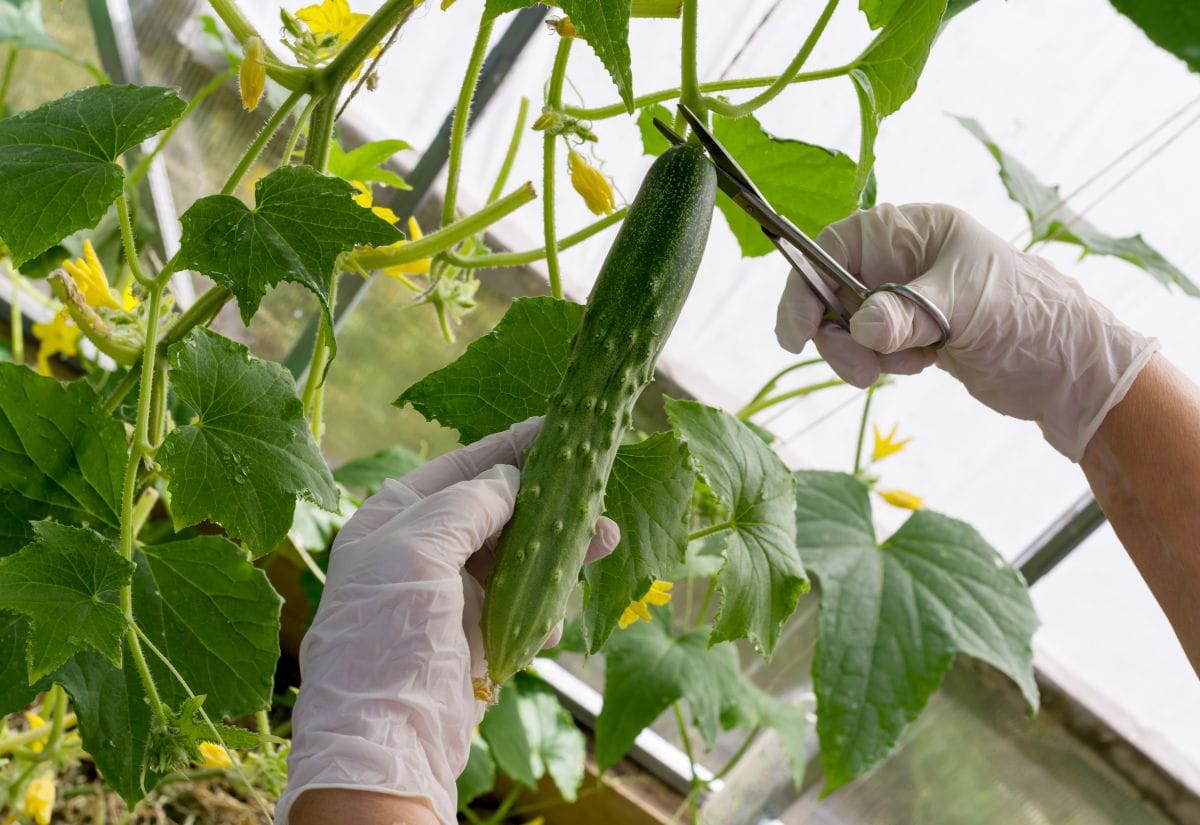
If your cucumber plants are getting unruly and taking over the garden, it is probably time to bring out the pruners. Cucumbers can grow into large vines that are notorious for suckering, and pruning can help keep your plants healthy, productive, and tidy especially if you are growing them up a trellis.
While you have your shears out, you can trim off some of the bottom leaves to help air circulation and let sunlight in. Or, you can pick off fruits that won’t have time to ripen. Will pruning the cucumber improve your harvest or make the cukes taste better? Keep reading to find out as we discuss the 5 steps to successfully prune your cucumbers.
Step 1: Start Pruning At The Right Time
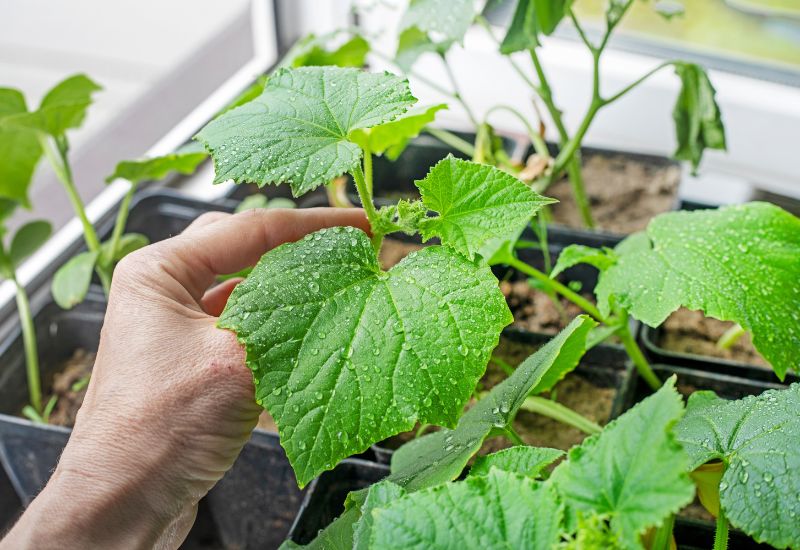
Start pruning cucumbers as soon as you transplant them into the garden. If you direct sow your seeds, you can begin pruning when the vines are about a month old, or when they are 30cm to 60cm (1-2ft) high.
If you wait until the plants are more mature, many of the lower suckers will have become quite established and it might be too hard on the plant to remove them. If the plants did get away on you, simply leave the larger suckers on the bottom of the plant and start pruning away any new ones that develop. Continue to prune your cucumbers at least once a month. For more rigorous maintenance, cucumbers will need to be pruned every 1 or 2 weeks to keep them under control.
Cucumbers are prodigious plants that grow very quickly in the warm summer months, so you will probably want to keep at it all season long once pruning starts. There are a number of advantages to maintaining a well-pruned plant, including:
Pruning isn’t for everyone, and here are some reasons you might not want to prune your cucumbers:
Step 2: Don’t Forget to Remove Suckers
The main reason to prune cucumbers is to limit the numbers of suckers it has. Suckers, also called lateral stems, grow from the main vine, andif left in place, they will turn into large secondary branches which will produce more and more suckers until you will end up with a dense, bushy vine.
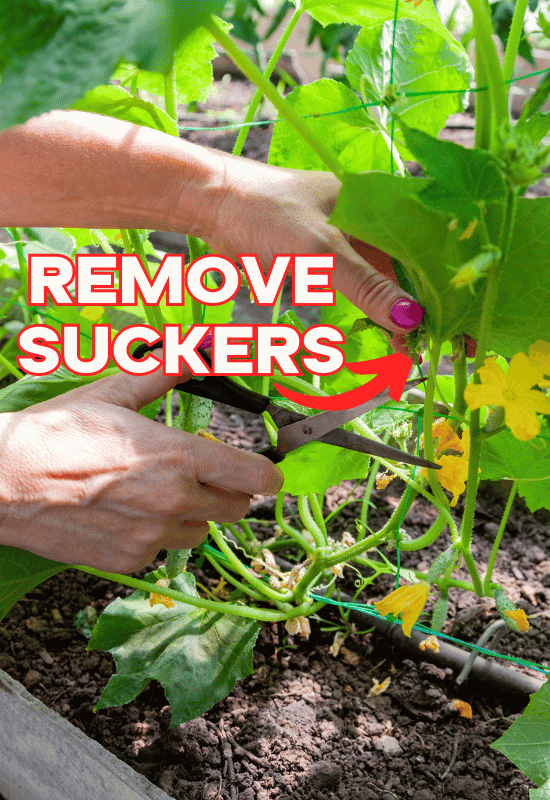
Remember, cucumber plants will grow very quickly in the summer, so you will have to check your plant every week to remove any unwanted suckers that have formed.
Why Remove Suckers
Suckers are typically removed to keep the vine manageable. This is particularly beneficial when training a cucumber to grow up a trellis and allows you to grow more cucumber plants on a single trellis.
Most commercial growers train cucumbers to grow up a string. This allows them to really maximize the space inside their greenhouses and simplifies harvesting. In this instance, all suckers are removed and the vine is trained as a single stem, called a leader.
In our gardens, we are not usually as aggressive in our pruning, and most gardeners prefer to leave at least a few suckers to produce a nice, bushy plant that is still practical.
How To Identify Suckers
Along the main stem of your cucumber plant are small growth points called nodes. The nodes look like little lumps in the otherwise smooth stem. At each node, four different things will happen: the plant will send out a female flower that will turn into a cucumber, a spindly tendril will grow to help the plant
Pruning Cucumbers To A Trellis
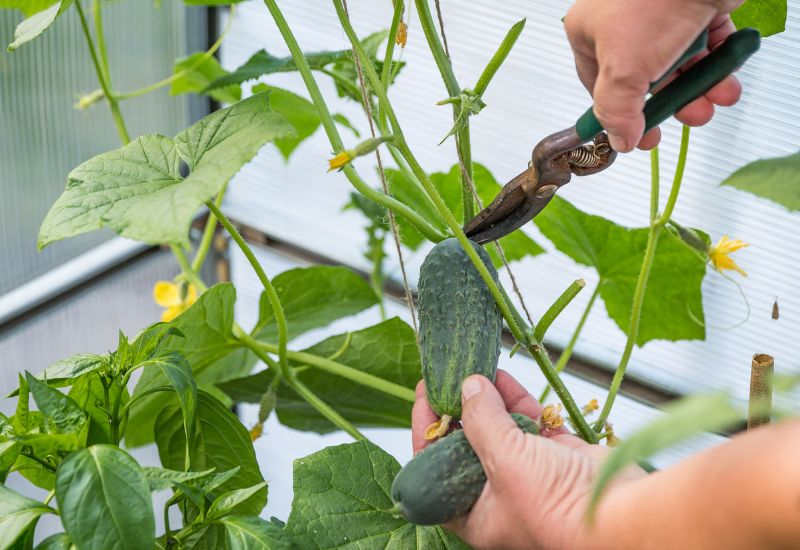
As your cucumber grows up its trellis, you might want to snip off suckers to keep it growing where you want it. Monitor your cucumber throughout the growing season, and remove any suckers that will send the vine off where you don’t want it.
The tendrils might not be sufficient to hold your vine to the trellis, especially when your plant is laden with fruits. While you are pruning off suckers, attach the remaining vine with clips or garden ties to keep it securely in place.
TIP: We use old pantihose or stretchy socks to tie our plants to the trellis. They are free and don’t damage the stems.
Don’t Cut Off Tendrils
As you prune off suckers, avoid snipping the thin tendrils. While removing tendrils won’t damage the plant, they will still provide extra support as your plant grows on its trellis.
Step 3: Remove Bottom Leaves
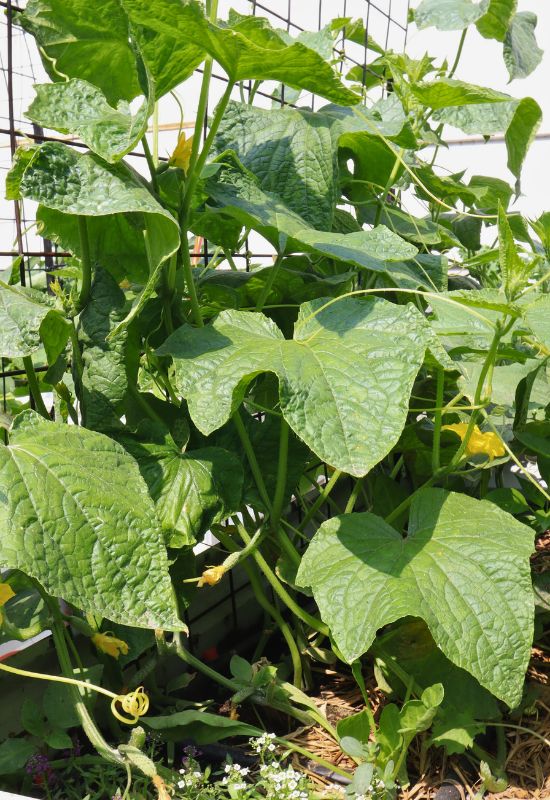
Once your plant has reached a decent size, it is often a good idea to trim off some of the bottom leaves. Opening up the base of the plant has a few advantages, for example:
It is important to not start removing leaves too early. Taking away foliage form young plants will significantly reduce its ability to photosynthesize which can have serious negative affects on the plant. You want to wait until the plant has enough foliage that it won’t miss a few leaves.
Some growers suggest removing everything from 4th node downwards, and while cucumbers will grow and produce very well with such an intensive pruning, we prefer to only remove some of the leaves (up to half) so the bottom of the plant is not completely exposed.
When trimming leaves, try and cut them off as close to the stem as possible. If there is too much of the leaf petiole left, it can rot and become a gateway to many diseases and insects to infect your plant.
Step 4: Cull Bad Fruits And Leaves
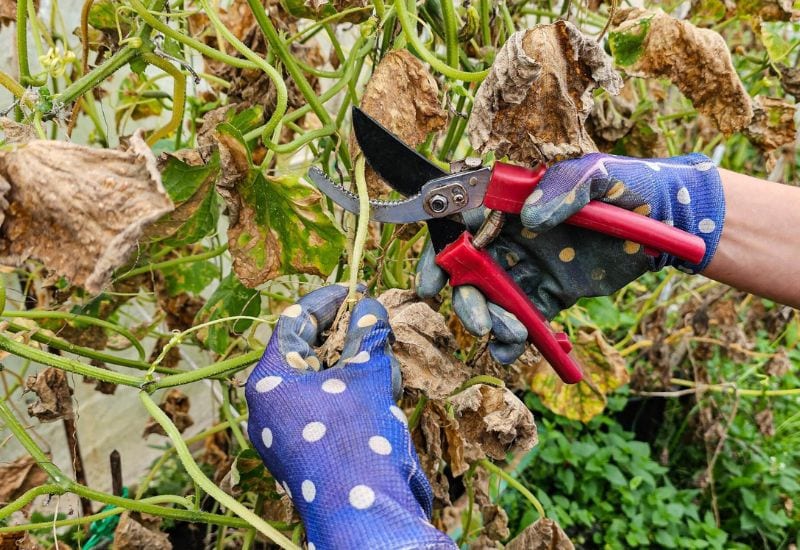
Most pruning is about removing healthy growth, so the remaining growth will grow even healthier and more productive. However, as you are pruning away at your cucumbers, keep your eyes open for any fruit, leaves or other foliage that have gone bad.
This includes any parts of the plant that show signs of disease, are extremely damaged, or are turning yellow and wilting. These “weak spots” can introduce disease or insects into the rest of your healthy cucumber plant.
TIP: Do not throw disease or infested foliage into the compost bin. Many of these issues can survive the heat of the composting process and will be reintroduced to your garden when you apply the compost. Always burn or throw away anything like this.
Step 5: End Of Season Pruning
Cucumbers are tender annuals that will not survive even the slightest frost. As your season winds down, you might be nervous for the ripening fruit that might not make it before the first fall frost sets in. Thankfully, pruning can help you get your crop off in a timely manner.
Topping
Topping is the practice of snipping the main stem at a node rather than a sucker. When you cut the tip of the plant’s vine, it will put its energy into the plant that is already there instead of continuing to grow larger, and some of that energy will be put towards ripening the cukes.
Topping has been known to help fruits ripen faster. This method is particularly helpful in northern climates with short growing seasons where the cucumbers might not otherwise have a chance to fully ripen before being frost-killed.
Culling Unripe Cukes
Another pruning technique that can help you get your crop off faster is to cull out any cucumbers that will not have time to ripen before the season ends.
As fall frost approaches, carefully select any cucumbers that are still too immature and snip them off the plant (remember, you can eat cucumbers at any stage of their growth though their flavor might not be as perfect). This will allow the plant to redirect its extra energy into ripening the rest of the cukes faster.
Again, this is a common practice amongst northern gardeners that I find particularly helpful in my Zone 2 garden.
Conclusion
I was always leery of pruning my plants, afraid that I would cause irreparable damage. Once I started, however, I found it was not nearly as scary as it seemed and turned out to be one of my favorite chores around the farm.
While I still sometimes make cuts in the wrong places, the benefits are often well worth the few mistakes and it is delightful to see a plant flourish after a careful pruning. I hope this guide was helpful and that you will have even more success than I have.
FAQ
If this is our first time pruning cucumbers, here are some questions you might be asking yourself:
Q: Do I have to prune my cucumber plant?
A: No, you certainly do not have to prune cucumbers. Many gardeners grow them quite well by letting the vines grow as they will. In certain situations, however, there can be many benefits to pruning.
Q: What happens if I cut off a tendril by accident?
A:Nothing. Cutting a tendril will not affect the health of the plant. If you remove too many tendrils, however, the plant won’t be able to climb very well so it probably won’t work very well on a trellis.
Q: Should I prune off cucumber flowers?
A:Pruning off cucumber flowers can be very beneficial if the vines are too small to bear fruit. The growth of immature plants can be retarded if they set fruit too early, so removing the flowers at this point can be very beneficial for the overall health of the plant.
Alternatively, you can prune off flowers towards the end of the year if they do not have enough time to develop fruits before frost.
Q: How often do I have to prune suckers (or laterals)?
A:This depends on how neat you want to keep your plant. If you want a very trim plant with a single leader, you will probably have to prune every week or so.
Q: Do I have to trim off cucumber leaves?
A: It is common to prune off some of the bottom leaves off the cucumber plant to reduce potential disease issues. However, if your garden is not prone to cucumber diseases, then it is perfectly fine to leave them alone. It is a good idea, however, to remove any sickly or infected leaves as soon as you see them.
Q: Do vining cucumbers have to grow on a trellis?
A: No, vining cucumbers can grow very well sprawled along the ground. They might be more prone to insect and disease issues however, but with proper care they can be very healthy.

Written By
Amber Noyes
Amber Noyes was born and raised in a suburban California town, San Mateo. She holds a master’s degree in horticulture from the University of California as well as a BS in Biology from the University of San Francisco. With experience working on an organic farm, water conservation research, farmers’ markets, and plant nursery, she understands what makes plants thrive and how we can better understand the connection between microclimate and plant health. When she’s not on the land, Amber loves informing people of new ideas/things related to gardening, especially organic gardening, houseplants, and growing plants in a small space.

